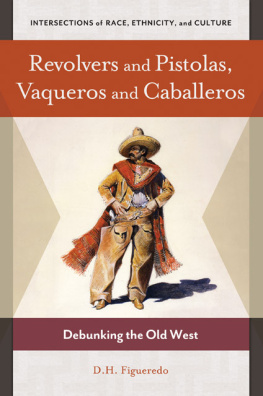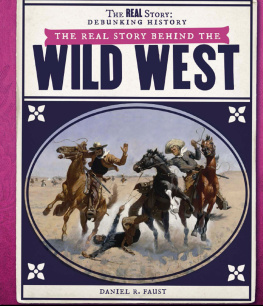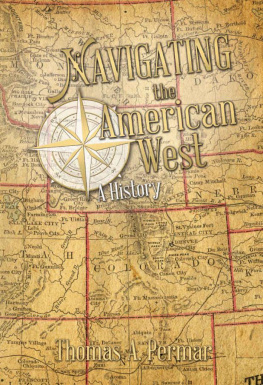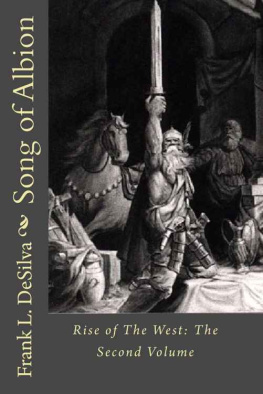

Copyright 2015 by D.H. Figueredo
All rights reserved. No part of this publication may be reproduced, stored in a retrieval system, or transmitted, in any form or by any means, electronic, mechanical, photocopying, recording, or otherwise, except for the inclusion of brief quotations in a review, without prior permission in writing from the publisher.
Library of Congress Cataloging-in-Publication Data
Figueredo, D. H., 1951
Revolvers and pistolas, vaqueros and caballeros : debunking the Old West / D.H. Figueredo.
pages cm. (Intersections of race, ethnicity, and culture)
Includes bibliographical references and index.
ISBN 978-1-4408-2918-5 (hardback : acid-free paper) ISBN 978-1-4408-2919-2 (ebook) 1. Hispanic AmericansWest (U.S.)History. 2. MexicansWest (U.S.)History. 3. SpaniardsWest (U.S.)History. 4. CowboysWest (U.S.)History. 5. Stereotypes (Social psychology)United StatesHistory. 6. West (U.S.)HistoryErrors, inventions, etc. 7. West (U.S.)Ethnic relationsHistory. 8. Hispanic Americans in popular culture. 9. West (U.S.)In popular culture. 10. West (U.S.)Folklore. I. Title.
F596.3.S75F54 2015
978.00468dc23 2014029033
ISBN: 978-1-4408-2918-5
EISBN: 978-1-4408-2919-2
19 18 17 16 15 1 2 3 4 5
This book is also available on the World Wide Web as an eBook.
Visit www.abc-clio.com for details.
Praeger
An Imprint of ABC-CLIO, LLC
ABC-CLIO, LLC
130 Cremona Drive, P.O. Box 1911
Santa Barbara, California 93116-1911
This book is printed on acid-free paper 
Manufactured in the United States of America
To my wife and faithful friend, Yvonne Massip,
and to my talented children Daniel and Gabriela:
what at a team they make!
In memory of Danilo and Norma Figueredo,
and Alfredo and Olivia Massip.
The desirability of a future that we must conquer is thus guaranteed by the memory of a past we have lost.
Italo Calvino
Contents
Series Foreword
Intersectionality, as termed by critical race scholar Kimberl Crenshaw in 1989, references the multiple and conjoining forces that constrain and oppress all peoples. Two decades before Crenshaws articulation, activist Frances Beale organized the Black Womens Alliance and then the Third World Womens Alliance to mobilize against the racism, sexism, heterosexism, and classism faced by women of color in the United States. Critically important was Beales recognition that African Americans, American Indians, Asian Americans, and Latino/as comprised a collective group, across racialized divides, as women of color, or in the parlance of the 1960s and 1970s, Third World women. The wider term linked the condition of women of color in the United States with women in Africa, Asia, the Caribbean, and Latin America.
African American women of the Combahee River Collective, a black feminist group formed in Boston in 1974, best described what Crenshaw later called intersectionality. We are committed, the Combahee River Statement declared in April 1977, to struggling against racial, sexual, heterosexual, and class oppression, and see as our particular task the development of integrated analysis and practice based upon the fact that the major systems of oppression are interlocking. The synthesis of those oppressions creates the conditions of our lives. Significantly, the theorists of the collective observed from their everyday life experiences that the forces that oppressed them were systematic and intersecting. They were not random but organized and not additive as in racism plus sexism plus heterosexism but relational and overlapping as in gendered races, sexualized genders, and so forth.
The power of those analyses and practices must not escape us in the 21st century. They are as fresh and vital as when they were first experienced and theorized. This series, Intersections of Race, Ethnicity, and Culture in America, aspires to continue and extend the struggles against all forms of oppression. Our authors understand the past as prologue, and they offer fresh perspectives to contemporary social issues in highly accessible language. Moreover, our authors present engagements beyond the whitenonwhite binary to relations among peoples of color and enlarge upon the U.S. social formation as race but also and simultaneously gender, sexuality, class, and nation. Finally, their studies show how peoples of color cast a different light on the United States, revealing the nation in its fullness and verity.
Peoples of color have reshaped America fundamentally, and we establish that claim in this series.
Gary Y. Okihiro
Acknowledgments
Dar a luz! That is a common expression used in Spanish by an author who has finished writing a book or is about to have a book published. It might be translated as to give light. The closer sentiment is about something that is coming out onto the light. The expression also refers to the act of giving birth, and you can almost see the infant in the warm and liquid darkness of the womb venturing out into the brightness of a brave world.
It makes obvious sense to the point of being trite. But the writing of a book is a creative endeavor: from the grayness of your brain to the light of the world around you. And if the writing of a book is an act of giving birth, there are many parents involved in the creation.
For me, it goes back to my own father. In another century and in another world, he and I spent many Saturday afternoons together roaming throughout Old Havana, the capitals colonial neighborhood. We usually finished the day at a movie house that specialized in programs for children: cartoons, shorts, and plenty of Three Stooges and Laurel and Hardy comedies. The movie house was El Cinecitothe little cinema. Quite often, black and white westerns were featured.
My father enjoyed westerns, just for the sake of the westerns; he didnt want messages, cultural lessons, political statementsjust good old-fashioned shootouts. I do as well. But over the years, the complexities of the subjects addressed by the western as a genre began to haunt me. I still enjoyed a shootout, but I also thought of the people in the background, the silent and self-effacing performers framed by the camera but seldom in the picture. Often, they were Mexicans. Through this book, I acknowledge their filmic and historic participation in the creation of what we call the Old West and of western movies.
I must acknowledge two writers who inspired me to work on this personal project. They dont know that they pointed me in this direction. Scholar and poet Gustavo Prez Firmat served as a model for my writing, especially his inventive and truly enjoyable volume Havana Habits. Emilio Bejels study of Jos MartJos Mart: Images of Memory and Mourningshowed me how to question and reinterpret what seems culturally obvious but might not be. Both writers are gifted poets and, though Im not a poet, because of their writings, I insert poetry in my own writing.
Novelist Alex Abella also prodded me into this project. His deep knowledge of California and the history of the Spanish and Mexican eras seeded this volume. He taught me one reality about writing: to engage the readers, there must be conflict. Hopefully, I have rendered, in an engaging manner, the conflicted story of the conquest of the American West.
In addition, the detective work carried on by author and scholar, Nicols Kanellos, Brown Foundation Professor of Hispanic Studies at the University of Houston and Director of Arte Pblico Press and Recovering the U.S. Hispanic Literary Heritage, unearthed hundreds of sources documenting the history of the Spanish and the Mexicans in the American West, sources that proved invaluable in my research.
Next page








